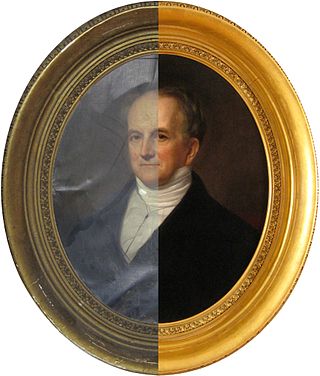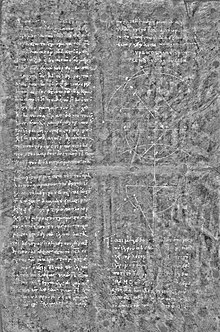
The conservation and restoration of cultural property focuses on protection and care of cultural property, including artworks, architecture, archaeology, and museum collections. Conservation activities include preventive conservation, examination, documentation, research, treatment, and education. This field is closely allied with conservation science, curators and registrars.

The Victoria and Albert Museum in London is the world's largest museum of applied arts, decorative arts and design, housing a permanent collection of over 2.8 million objects. It was founded in 1852 and named after Queen Victoria and Prince Albert.

With respect to cultural property, conservation science is the interdisciplinary study of the conservation of art, architecture, technical art history and other cultural works through the use of scientific inquiry. General areas of research include the technology and structure of artistic and historic works. In other words, the materials and techniques from which cultural, artistic and historic objects are made. There are three broad categories of conservation science with respect to cultural heritage: understanding the materials and techniques used by artists, study of the causes of deterioration, and improving techniques and materials for examination and treatment. Conservation science includes aspects of materials science, chemistry, physics, biology, and engineering, as well as art history and anthropology. Institutions such as the Getty Conservation Institute specialize in publishing and disseminating information relating to both tools used for and outcomes of conservation science research, as well as recent discoveries in the field.
The conservation and restoration of illuminated manuscripts is the care and treatment of illuminated manuscripts which have cultural and historical significance so that they may be viewed, read, and studied now and in the future. It is a specialty case of the conservation and restoration of parchment within the field of conservation and restoration of books, manuscripts, documents and ephemera.
Conservation and restoration of movable cultural property is a term used to denote the conservation of movable cultural property items in libraries, archives, museums and private collections. Conservation encompasses all the actions taken toward the long-term preservation of cultural heritage. Activities include examination, documentation, treatment, and preventive care, which is supported by research and education. Object conservation is specifically the actions taken to preserve and restore cultural objects. The objects span a wide range of materials from a variety of cultures, time periods, and functions. Object conservation can be applied to both art objects and artifacts. Conservation practice aims to prevent damage from occurring, a process known as 'preventive conservation'. The purpose of preventive conservation is to maintain, and where possible enhance, the condition of an object, as well as managing deterioration risks, such as handling and environmental conditions. Historically, object conservation was focused on the category of fine arts but now many different types of objects are conserved. Each type of object material, typically denoted by organic or inorganic then the specific medium, requires a specialized professional conservator and often requires collaborative work between museum staff, scientists, and conservators.

Iron, steel, and ferrous metals constitute a large portion of collections in museums. The conservation and restoration of iron and steel objects is an activity dedicated to the preservation and protection of objects of historical and personal value made from iron or steel. When applied to cultural heritage this activity is generally undertaken by a conservator-restorer. Historically, objects made from iron or steel were created for religious, artistic, technical, military and domestic uses. Though it is generally not possible to completely halt deterioration of any object, the act of conservation and restoration strives to prevent and slow the deterioration of the object as well as protecting the object for future use. One of the first steps in caring for iron is to examine them and determine their state, determine if they are corroding, and consider options for treatment.

A paintings conservator is an individual responsible for protecting cultural heritage in the form of painted works of art. These individuals are most often under the employ of museums, conservation centers, or other cultural institutions. They oversee the physical care of collections, and are trained in chemistry and practical application of techniques for repairing and restoring paintings.
The Association of North American Graduate Programs in the Conservation of Cultural Property, better known by its acronym ANAGPIC, is an annual student conference held by the North American conservation graduate programs. The conference sees students present lectures of the highest caliber, sharing their research, leadership, and training with peers and faculty.

An Objects conservator is a professional, working in a museum setting or private practice, that specializes in the conservation of three-dimensional works. They undergo specialized education, training, and experience that allows them to formulate and implement preventive strategies and invasive treatment protocols to preserve cultural property for the future. Objects conservators typically specialize in one type of material or class of cultural property, including metals, archaeological artifacts, ethnographic artifacts, glass, and ceramic art. Objects conservation presents many challenges due to their three-dimensional form and composite nature.

A conservation scientist is a museum professional who works in the field of conservation science and whose focus is on the research of cultural heritage through scientific inquiry. Conservation scientists conduct applied scientific research and techniques to determine the material, chemical, and technical aspects of cultural heritage. The technical information conservation scientists gather is then used by conservator and curators to decide the most suitable conservation treatments for the examined object and/or adds to our knowledge about the object by providing answers about the material composition, fabrication, authenticity, and previous restoration treatments.

The conservation and restoration of Tibetan thangkas is the physical preservation of the traditional religious Tibetan painting form known as a thangka. When applied to thangkas of significant cultural heritage, this activity is generally undertaken by a conservator-restorer.

The conservation and restoration of painting frames is the process through which picture frames are preserved. Frame conservation and restoration includes general cleaning of the frame, as well as in depth processes such as replacing damaged ornamentation, gilding, and toning.

Textile stabilization is a conservation method for fiber and yarn-based cloth intended to mitigate damage, prevent degradation and preserve structural integrity. Stabilization is part of a broad set of techniques in the field of conservation and restoration of textiles typically undertaken by a specialist or textile conservator. Appropriate treatment is determined through risk assessment and close examination of a textile's characteristics and the nature of the damage. Organic and synthetic fibers become weak due to age, handling, and environmental exposure and display physical deterioration such as fraying, planar distortion, loss, and change in surface character. Treatment involves reinforcing tensile strength and reintegration of parts for aesthetic, functional, and historic preservation. Methods can include stitching, darning, reweaving, and the attachment of supports through overlays and underlays. Hand-sewing follows the mantra of “gently does it” using fine needles, supple yarns, and a light touch. Heavily damaged and fragile fabrics often require stabilization through adhesive consolidation, though this is less common. It is essential that conservators consider physical and chemical compatibility along with future treatability in choosing a stabilization technique.

The conservation and restoration of paintings is carried out by professional painting conservators. Paintings cover a wide range of various mediums, materials, and their supports. Painting types include fine art to decorative and functional objects spanning from acrylics, frescoes, and oil paint on various surfaces, egg tempera on panels and canvas, lacquer painting, water color and more. Knowing the materials of any given painting and its support allows for the proper restoration and conservation practices. All components of a painting will react to its environment differently, and impact the artwork as a whole. These material components along with collections care will determine the longevity of a painting. The first steps to conservation and restoration is preventive conservation followed by active restoration with the artist's intent in mind.
The conservation and restoration of ancient Greek pottery is a sub-section of the broader topic of conservation and restoration of ceramic objects. Ancient Greek pottery is one of the most commonly found types of artifacts from the ancient Greek world. The information learned from vase paintings forms the foundation of modern knowledge of ancient Greek art and culture. Most ancient Greek pottery is terracotta, a type of earthenware ceramic, dating from the 11th century BCE through the 1st century CE. The objects are usually excavated from archaeological sites in broken pieces, or shards, and then reassembled. Some have been discovered intact in tombs. Professional conservator-restorers, often in collaboration with curators and conservation scientists, undertake the conservation-restoration of ancient Greek pottery.
The conservation-restoration of panel paintings involves preventive and treatment measures taken by paintings conservators to slow deterioration, preserve, and repair damage. Panel paintings consist of a wood support, a ground, and an image layer. They are typically constructed of two or more panels joined together by crossbeam braces which can separate due to age and material instability caused by fluctuations in relative humidity and temperature. These factors compromise structural integrity and can lead to warping and paint flaking. Because wood is particularly susceptible to pest damage, an IPM plan and regulation of the conditions in storage and display are essential. Past treatments that have fallen out of favor because they can cause permanent damage include transfer of the painting onto a new support, planing, and heavy cradling. Today's conservators often have to remediate damage from previous restoration efforts. Modern conservation-restoration techniques favor minimal intervention that accommodates wood's natural tendency to react to environmental changes. Treatments may include applying flexible battens to minimize deformation or simply leaving distortions alone, instead focusing on preventive care to preserve the artwork in its original state.
Cultural property imaging is a necessary part of long term preservation of cultural heritage. While the physical conditions of objects will change over time, imaging serves as a way to document and represent heritage in a moment in time of the life of the item. Different methods of imaging produce results that are applicable in various circumstances. Not every method is appropriate for every object, and not every object needs to be imaged by multiple methods. In addition to preservation and conservation-related concerns, imaging can also serve to enhance research and study of cultural heritage.
The conservation and restoration of Pompeian frescoes describes the activities, methods, and techniques that have historically been and are currently being used to care for the preserved remains of the frescoes from the archeological site of Pompeii, Italy. The ancient city of Pompeii is famously known for its demise in A.D. 79 after the fatal eruption of Mount Vesuvius wiped out the population and buried the city beneath layers of compact lava material. In 1738, King Charles III or Charles of Bourbon, began explorations in Portici, Resina, Castellammare di Stabia, a Civita, where it was believed that the ancient cities of Pompeii, Stabiae, and Herculaneum were buried beneath. The first phase of the excavations at Pompeii started in 1748, which led to the first conservation and restoration efforts of the frescoes since their burial, and in 1764, open-air excavations began at Pompeii. Pompeii has a long history of excavation and restoration that began without a strong foundation or strategy. After centuries of cronyism, recurring financial shortages, and on-again-off-again restoration, the city's frescoes and structures were left in poor condition. In 1997, Pompeii was added to the UNESCO List of World Heritage Sites.

The conservation-restoration of Thomas Eakins' The Gross Clinic refers to the on-going conservation-restoration treatments of American painter Thomas Eakins' 1875 painting The Gross Clinic throughout the 20th and 21st centuries. These treatments are a testament to the changing methodologies undertaken in the field of paintings conservation.




















